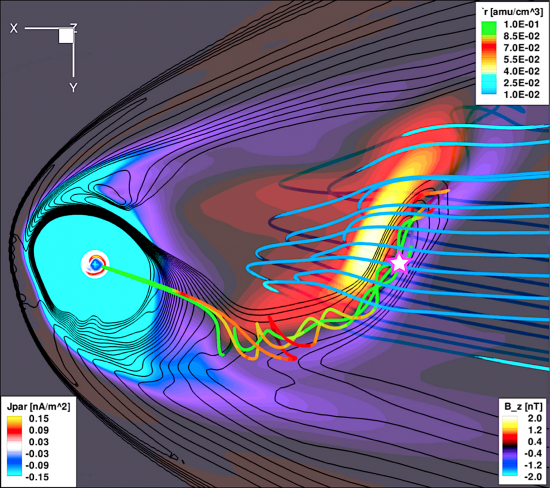
Saturn’s magnetospheric flux rope map. Credit: Xianzhe Jia, Kenneth C. Hansen, Tamas I. Gombosi, Margaret G. Kivelson, Gabor Tóth, Darren L. DeZeeuw, and Aaron J. Ridley
Mar 21, 2017
Electromagnetic filaments connect Saturn with the Sun.
The plasmasphere of Saturn is highly energetic, enough so that lightning up to a million times more powerful than anything on this planet was observed. Saturn emits 2.3 times more energy than it receives from the Sun. 90 megawatts of X-rays were detected by Cassini, but even that was not attributed to its electrical nature. Instead, Saturn’s atmosphere is said to reflect X-rays from the Sun, a “surprising” discovery. It is that magnetosphere that traps and accelerates charged particles from Saturn.
In part, its energetic fields exist because Saturn is quite large compared to Earth; its equatorial diameter is 120,500 kilometers. Since it rotates so fast, 10 hours, 34 minutes, its polar diameter is 108,700 kilometers due to “flattening”: its rotational speed pushes the low-density atmosphere outward at the equator.
According to astrophysicists, the rapid rotation “flings cold, dense plasma outward from the inner magnetosphere by centrifugal force”. As the colder plasma accumulates in the outer magnetosphere, hotter, more tenuous plasma cycles back into the inner magnetosphere. Cassini observed narrow “jets” of hot plasma moving inward, tentatively identified by mission specialists as part of the exchange sequence.
It is assumed by mainstream scientists that Saturn’s 37,000 kilometer per hour rotational speed is the only mechanism available that can “force” cold plasma into the outer magnetosphere and start the recycling process with the hot plasma.
A recent press release announced that Cassini detected charged particles accelerated to high energies. They believe that the impetus experienced by the ions is similar to that which is felt by particles that are sped up by the shockwaves from supernovae.
As written previously, however, the idea that shockwaves, or kinetic effects, in general, are responsible for high speed particles is at odds with Electric Universe theory. Hot gas, sonic booms, wind, turbulence, blast fronts, and other commonly applied causal events do not provide the necessary energies. Of course, space scientists have yet to consider the role of charge distribution within the plasma of space. Instead, a charge-neutral Solar System is what they perceive.
In an Electric Universe, Saturn moves within the plasmasphere of the Sun and interacts with the Sun’s electric field. Planets and moons in the Solar System are charged bodies. They are not isolated in “empty” space. Enceladus, Dione and Tethys all move within the plasmasphere of Saturn, so it is only to be expected that they would transact electrically with their primary. The simplest, most straightforward explanation for the charged particle acceleration is electric discharge, so there is no need to conjure implausible internal dynamics to account for them.
In fact, other investigators admit to Saturn’s interactions with its moons: “…the observed double-peaked (‘butterfly’) pitch-angle distributions [of the plasma] result from the transport of plasma from regions near the orbits of Dione and Tethys…”
Stephen Smith












